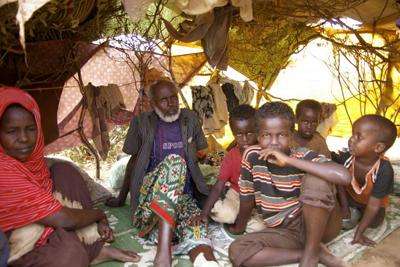Many Willing to Risk Return to War Zone Because of Food and Water Shortages
Nairobi/Geneva/New York, May 18, 2009 – More than 270,000 refugees who have fled war in Somalia are facing such alarming shortages of food, water, and adequate shelter in severely overcrowded camps in northern Kenya that many are considering returning to the Somali war zone, the international medical humanitarian organization Doctors Without Borders/Médecins Sans Frontières (MSF) said today.
An estimated 5,000 people arrive monthly to the Dagahaley, Ifo, and Hagadera camps located in the Kenyan border town of Dadaab, which are operated by the United Nations High Commission for Refugees (UNHCR). Health and nutrition surveys carried out by MSF in April in the Dagahaley Camp, where the organization provides medical services, reveal high levels of acute malnutrition among a population already facing dwindling food aid rations.
“The situation is simply scandalous,” said Joke Van Peteghem, MSF head of mission in Kenya. “These refugees have risked everything to escape the fighting in Somalia. Now some are telling us they would rather take their chances in Mogadishu than die slowly here. Aid agencies are present in the camps but are not able to meet the immense and rapidly growing needs of this war weary population. We need action now.”
Since Kenya has officially closed its border with Somalia, the registration process for refugees is disorganized and far too slow, and proper medical screenings and distribution of basic supplies are not taking place.
A UNHCR delegation is visiting the camps today. MSF calls upon UNHCR, international donors, and the Kenyan government to urgently address the lack of assistance and protection provided to arriving refugees, and the dire living conditions in the camps.
People fleeing Somalia for the last 18 years have settled in the Dadaab camps. In 2008, pushed by intense levels of violence in their country, more than 50,000 people arrived, swelling the combined camp populations to at least 270,000 people. Each camp can accommodate 30,000 people, but are home to roughly three times that number.
“The camps are public health time bombs,” said Donna Canali, a nurse who recently completed an assignment as MSF project coordinator in Dagahaley Camp. “The refugees, many of whom are already suffering from serious war-related injuries or illnesses, are packed together without the bare minimum to survive -- water, food, shelter, and medical care. After all these people have endured, how can their most basic needs continue to be so woefully neglected?”
The recent MSF survey in Dagahaley Camp revealed a 22.3 percent prevalence of acute malnutrition among the population, well above what is considered the emergency threshold. The low level of food stocks in a World Food Program warehouse in Dadaab have led to a 30 percent reduction of rations distributed in the camps.
Water and sanitation services in the camps are also dangerously scarce. Some residents of Dagahaley Camp survive on as little as three liters of water per day. Additional boreholes must be dug immediately. Poorly maintained and insufficient latrines are increasing the threat of epidemics.
Shelters are also totally inadequate. People are forced to construct makeshift structures and some are living under trees. While plans are underway to construct a fourth camp, much more physical living space is needed to ensure basic needs are met.
MSF is working in Dagahaley Camp in Dadaab, home to 91,000 people. The organization operates a primary health care clinic for 25,000 people living in two sectors of the settlement, carrying out 150 outpatient consultations per day and providing vaccination services and nutritional support to moderately and severely malnourished children.




